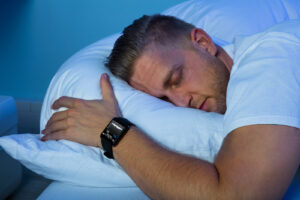A multiple sleep latency test (MSLT) measures how fast you fall asleep and whether you enter REM sleep during a short nap. By recording how quickly you fall asleep during the test, an MSLT can measure your level of daytime sleepiness. Results can help doctors diagnose or rule out the sleep disorders narcolepsy and idiopathic hypersomnia.
How Does a Multiple Sleep Latency Test Work?
An MSLT takes place in a specialized sleep laboratory the morning after a sleep study. During the test, a person takes a 15-minute nap once every 2 hours, for a total of five naps. While the person naps, trained technicians use electrodes and other monitors to track different types of activity, including:
- Body movements or sounds
- Eye movements
- Brain activity
- Electrical activity of the heart
A health care provider can then use this information to determine how long it takes a person to fall asleep and how quickly they enter REM sleep. Along with the results of other tests, this information can help doctors understand whether a person has certain sleep disorders.
What Can the MSLT Diagnose?
On its own, an MSLT cannot diagnose a sleep disorder. Instead, health providers consider the results of an MSLT in combination with a person’s symptoms, medical history, and the results of a physical exam.
Doctors may recommend multiple sleep latency testing may be recommended if they suspect that a person may have narcolepsy or idiopathic hypersomnia.
Narcolepsy
Narcolepsy is a chronic sleep disorder that can cause people to suddenly fall asleep during the day and have trouble sleeping at night. Other symptoms of narcolepsy include excessive daytime sleepiness, muscle weakness, sleep paralysis, and hallucinations before falling asleep.
To diagnose narcolepsy, doctors learn about a person’s symptoms and medical history before performing several tests, including a sleep study and an MSLT. They may also recommend genetic testing and testing of a person’s spinal fluid.
The MSLT is used when diagnosing narcolepsy because it helps doctors measure how long it takes a person to fall asleep and provides information about how quickly they enter REM sleep. During an MSLT, people with narcolepsy typically fall asleep and enter REM sleep more quickly than people without narcolepsy.
Idiopathic Hypersomnia
Idiopathic hypersomnia is a sleep disorder in which a person feels abnormally sleepy. Unlike other types of hypersomnia, idiopathic hypersomnia may be diagnosed when there is no identifiable cause of a person’s symptoms. In addition to severe tiredness, people with idiopathic hypersomnia often have trouble waking up due to high levels of sleep inertia.
To diagnose idiopathic hypersomnia, a doctor starts by asking about a person’s symptoms and sleep history. They then conduct a sleep study, a multiple sleep latency test, and sometimes additional tests to rule out other causes of excessive tiredness.
The results of an MSLT in a person with idiopathic hypersomnia will show that they fall asleep quickly, as is also the case with narcolepsy. However, people with idiopathic hypersomnia do not always move rapidly into REM sleep, which can help doctors distinguish between this condition and narcolepsy.
Is the MSLT a Potential Tool for You?
If your doctor suspects that you may have a sleep disorder like narcolepsy or idiopathic hypersomnia, they may recommend a sleep study and an MSLT to evaluate your sleep. Prior to considering this test, your doctor may start by asking about your medical history and symptoms. Questions may relate to:
- Current medications
- Your level of daytime sleepiness
- How often you fall asleep during daytime activities
- When you go to bed and wake up
- How often you nap and for how long
- Snoring, choking, or gasping while asleep
- Discomfort in the legs when inactive
- Any other symptoms you’ve noticed
Based on the doctor’s assessment, they may recommend testing to find the cause of excessive sleepiness. This may include an MSLT the day after a sleep study.
How to Prepare for the MSLT
Prior to arriving at a sleep laboratory for a sleep study followed by an MSLT, your health care provider will ask you to take several steps to prepare for testing.
- Get Adequate Sleep: Maintain a regular sleep schedule and document your sleep patterns for up to two weeks leading up to an MSLT.
- Ask About Medications: Certain medications, like antidepressants, can change your sleep patterns in a way that could interfere with the results of an MSLT. Your doctor may ask you to stop them several weeks prior to the test. But do not stop taking any medications before discussing this with the doctor who prescribed them.
- Avoid Certain Activities: Your doctor may ask you to change certain habits a day before an MSLT if they could affect the test results. This may include avoiding strenuous physical activity, caffeine, and exposure to bright lights.
Preparations also depend on any other tests performed during the same visit, so it’s important to discuss how to prepare with your doctor or sleep specialist.
What Can You Expect During the MSLT?
When you arrive at the sleep lab, a trained professional will walk you through what to expect during the sleep study and MSLT. For people also getting an MSLT the next day, the sleep study takes place in a private room within a sleep laboratory at a hospital or clinic.
A technician will begin by explaining the process and helping you get comfortable, before setting up equipment that will monitor your sleep overnight. In the morning, the technician will finish the sleep study around one and a half to three hours before starting the MSLT.
When it’s time for the MSLT, the technician will set up the monitoring equipment. After the test is set up and you are comfortable, you will then try to take five 15-minute naps, with two-hour breaks between naps. During the breaks, you should stay awake but avoid stimulating activities like smoking for 30 minutes before your next nap.
After your last nap, the monitoring equipment will be removed and you will be able to return home.
What Do MSLT Results Mean?
A multiple sleep latency test helps to determine a person’s sleep latency and whether they experience sleep-onset REM periods.
- Sleep Latency: Sleep latency is the medical term for how quickly a person falls asleep. While there is no sleep latency that experts consider normal, falling asleep in eight minutes or less suggests narcolepsy or idiopathic hypersomnia.
- Sleep-Onset Rapid Eye Movements: Sleep-onset REM periods (SOREMPs) occur when a person enters REM sleep within 15 minutes of falling asleep. While most people enter REM sleep around 90 minutes after falling asleep, people with narcolepsy typically do so within 15 minutes at least twice during an MSLT.
Although the results of this test can help doctors assess for narcolepsy and idiopathic hypersomnia, an MSLT is only one part of the diagnostic process. Your health care provider will consider your MSLT results alongside your symptoms and the results of other tests before making a diagnosis.
References
Ask the Sleep Doctor
Have questions about sleep? Submit them here! We use your questions to help us decide topics for future articles, videos, and newsletters. We try to answer as many questions as possible. You can also send us an email. Please note, we cannot provide specific medical advice, and always recommend you contact your doctor for any medical matters.








